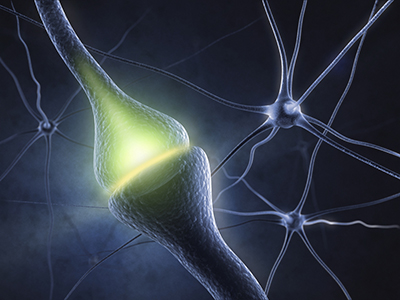Acoustic method could offer non-invasive, non-addictive remedy

Neuromodulation comprises a range of therapeutic approaches to relieving symptoms, such as pain or tremors, or to restore movement or function. Therapeutic stimulation of neurons with electrical energy or chemicals—and potentially with acoustic waves—can amplify or dampen neuronal impulses in the brain or body. Acoustic signals in the form of ultrasound offer a promising class of neuromodulation which would be an especially valuable approach because it is non-invasive—no surgical procedure to implant electrodes for stimulation is required. Ultrasound offers a temporary modulation that can be tuned for a desired effect. Now researchers have demonstrated that it has the potential to be targeted at neurons with specific functions.
A team led by Bin He, Ph.D., professor of biomedical engineering at Carnegie Mellon University, and funded in part by the National Institute of Biomedical Imaging and Bioengineering (NIBIB), has demonstrated the potential of a neuromodulation approach that uses low-intensity ultrasound energy, called transcranial focused ultrasound—or tFUS. In a paper published in the May 4, 2021, issue of Nature Communications, the authors describe tFUS in experiments with rodents that demonstrate the non-invasive neuromodulation alternative.
“Transcranial focused ultrasound is a promising approach that could be used to treat forms of chronic pain, among other applications,” said Moria Bittmann, Ph.D., director of the NIBIB program in Biorobotic Systems. “In conditions where symptoms include debilitating pain, externally generated impulses of ultrasound at controlled frequencies and intensity could inhibit pain signals.”
For their studies, He and his team designed an assembly that included an ultrasound transducer and a device that records data from neuron signals, called a multi-electrode array. During experiments with anesthetized rodents, the researchers penetrated the skull and brain with various brief pulses of acoustic waves, targeting specific neurons in the brain cortex. They simultaneously recorded the change in electrophysiological signals from different neuron types with the multi-electrode array.
When a signal is sent from one neuron to another, whether engaging the senses or controlling movement, the firing of that signal across the synapse, or junction, between neurons is called a spike. Two types of neurons observed by the researchers are excitatory and inhibitory neurons. When the researchers used tFUS to emit repeated bursts of ultrasound stimulation directly at excitatory neurons, they observed an elevated impulse rate, or spike. They observed that inhibitory neurons subjected to the same tFUS energy did not display a significant spike rate disturbance. The study demonstrated that the ultrasound signal can be transmitted through the skull to selectively activate specific neuron sub-populations, in effect targeting neurons with different functions.
“Our research addresses an unmet need to develop non-toxic, non-addictive, non-pharmacologic therapies for human use,” said He. “We hope to further develop the tFUS approach with variation in ultrasound frequencies and to pursue insights into neuronal activity so that this technology has the optimal chance for benefiting brain health.”
The application of this research has broad implications; it’s not just limited to one disease. For many people suffering from pain, depression and addiction, He believes non-invasive tFUS neuromodulation could be used to facilitate treatment. "If we can localize and target areas of the brain using acoustic, ultrasound energy, I believe we can potentially treat a myriad of neurological and psychiatric diseases and conditions,” He said.
The editors at Nature Communications selected the paper for a special feature, called “From brain to behaviour [sic],” which comprises some of the most exciting work on the brain published this year by the journal.
This work was supported, in part, by NIH grants from NIBIB (EB029354, EB021027), the National Institute of Mental Health (MH114233), the National Center for Advancing Translational Sciences (AT009263), and the National Institute of Neurological Disorders and Stroke (NS096761).
Read the paper: Kai Yu, Xiaodan Niu, Esther Krook-Magnuson, Bin He. Intrinsic functional neuron-type selectivity of transcranial focused ultrasound neuromodulation. Nature Communications, 2021; 12 (1) DOI: 10.1038/s41467-021-22743-7
This Science Highlight describes a basic research finding. Basic research increases our understanding of human behavior and biology, which is foundational to advancing new and better ways to prevent, diagnose, and treat disease. Science is an unpredictable and incremental process — each research advance builds on past discoveries, often in unexpected ways. Most clinical advances would not be possible without the knowledge of fundamental basic research.
